
From Dou to De Hooch: Dutch Old Masters
Did you know that Waddesdon Manor houses an outstanding collection of Dutch paintings?
Among Waddesdon’s treasures are French paintings by Antoine Watteau (1684-1721), Jean-Siméon Chardin (1699-1779) and François Boucher (1703-1770), and English portraits by Sir Joshua Reynolds (1723-1792), Thomas Gainsborough (1727-1788) and George Romney (1734-1802), line its walls.
In light of the upcoming exhibition Prized Possessions: Dutch Paintings from National Trust Houses at the Holborn Museum, which brings together over twenty masterpieces of Dutch art from across the country, visitors to Waddesdon may be interested to discover its outstanding collection of Dutch Old Masters, including works by Gerrit Dou (1613-1675), Aelbert Cuyp (1620-1691), Gabriel Metsu (1629-1667) and Pieter de Hooch (1629-1684). In 2016, the collection was further enriched by Isack Van Ostade’s magnificent Figures outside an Inn, allocated to the National Trust for Waddesdon by Lord Rothschild under the Cultural Gifts Scheme.
The seventeenth-century was a Golden Age for Dutch art. A growing middle-class commissioned portraits of themselves while the shifting Dutch landscape captured artists’ imagination. Genre painting focused upon scenes of everyday life – often conveying a moralising theme.
Dutch art shaped Baron Ferdinand de Rothschild’s life from an early age. Long before he embarked upon creating his French château in the Buckinghamshire hills, Ferdinand recalled ‘…learning under my mother’s tuition to distinguish a Teniers from an Ostade or a Wouvermans from a Both.’ Today, much of Ferdinand’s treasured collection still hangs in Waddesdon’s Morning Room, where it can be appreciated as he intended.
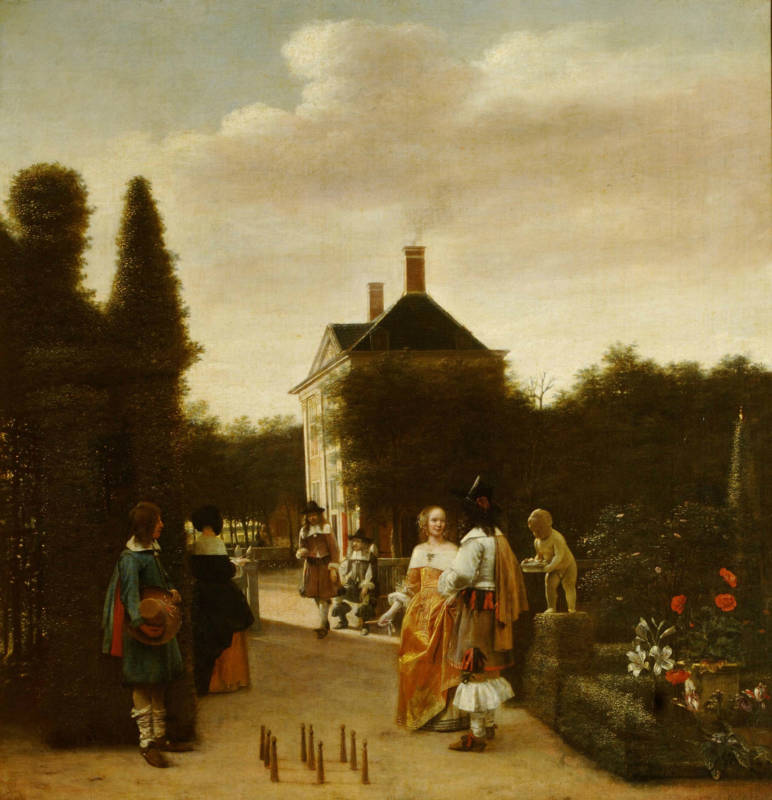
The Game of Love
Courting couples gather under the evening sky to play skittles. The central figures, dressed in shimmering gold satin, converse, as a bystander, removing his hat, attempts to join the conversation. Behind, a man prepares to bowl, watched by a man and a woman. The drama of people watching each other encourages the spectator of the painting to wonder who is interested in whom. The ‘Garden of Love’ theme is emphasised by the statue of Cupid and flowering red roses nearby.
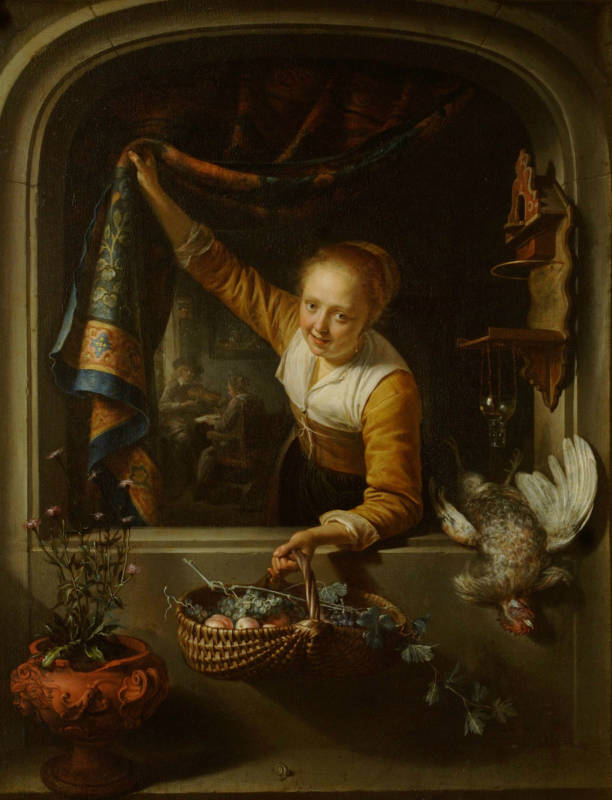
Fruits of innocence?
What appears to be a scene of innocent domesticity may mask a more salacious truth. The maid looks suggestively, out at the viewer, offering the fruits of her basket. She draws back the curtain revealing a genteel couple making music together. The empty perch and birdcage in the background allude to a loss of virtue, while the dead fowl acts as a double entendre – the Dutch word vogel (bird) being a slang term for ‘copulation’. Gerrit Dou (1613-1675) favoured this type of moralising theme. The distorted reflection in the glass hanging from the perch may be a self-portrait.
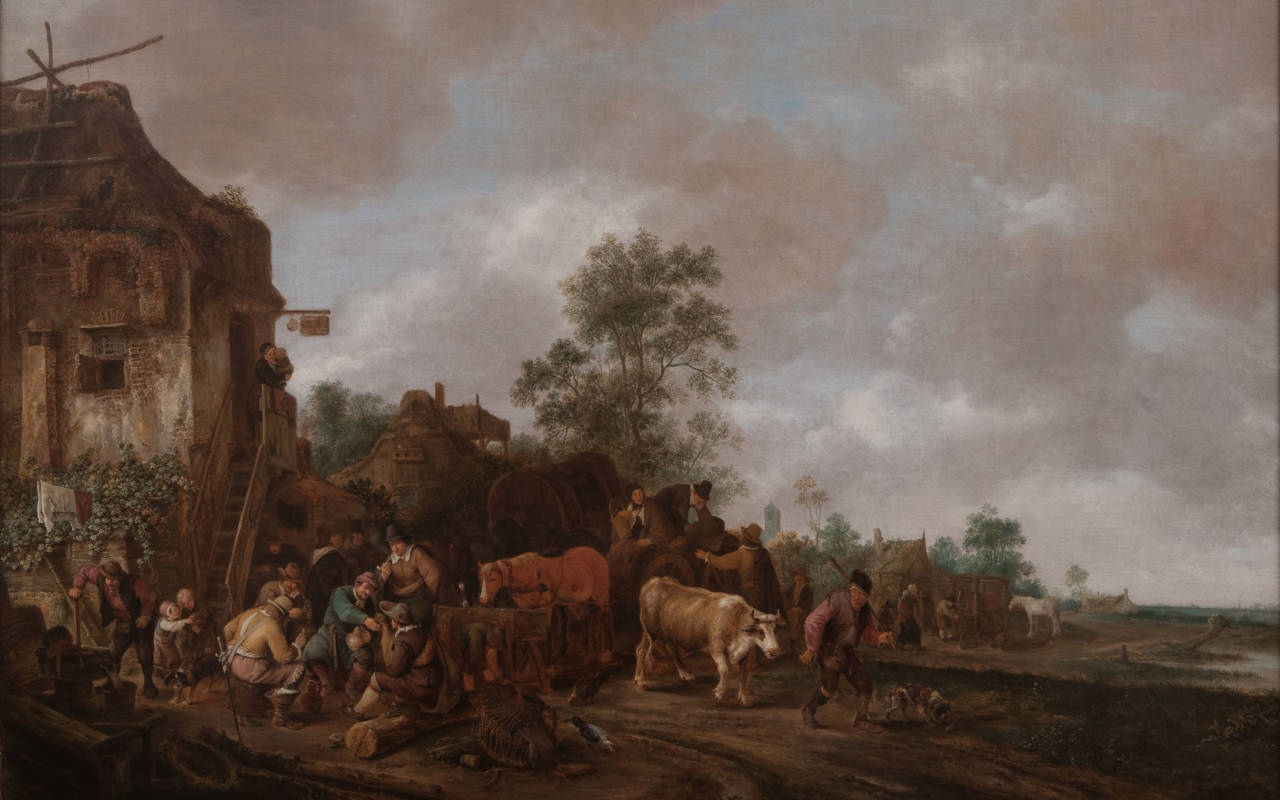
Figures outside an Inn was allocated to Waddesdon in 2016 under the governments Cultural Gifts Scheme. Long recognised as one of Isack van Ostade’s finest works, this cheerful view of peasant life demonstrates the influence of Isack’s tutor, and elder brother, Adriaen, as well as conveying the artist’s love for landscape. In the foreground a group of men drink and smoke pipes. They fail to notice the arrival of the travellers, dismounting from their carriage. A woman, with child in arms, watches from the entrance to the inn – as denoted by the jug hanging above the door.
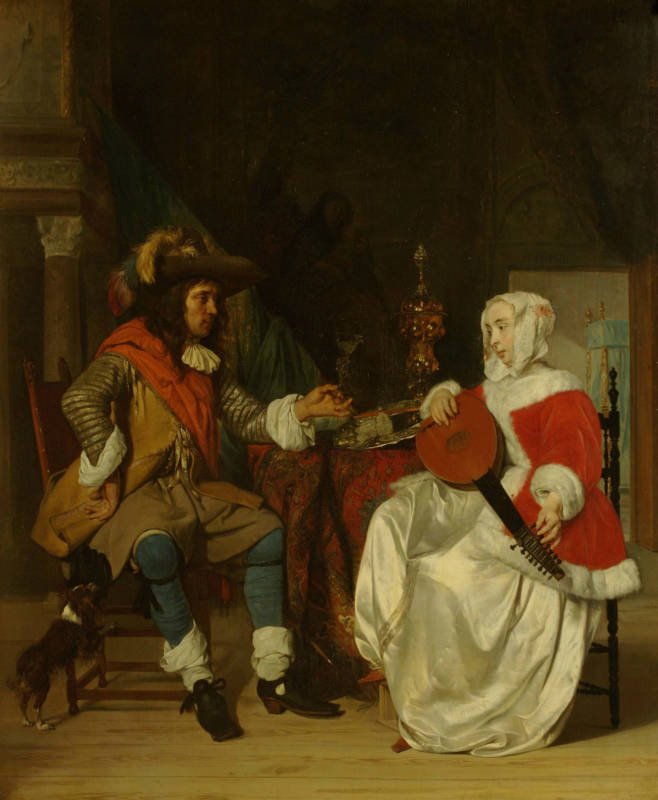
Indecent proposal?
Here Metsu focuses upon the turning point in this encounter. The man, dressed in military uniform, gazes, self-assuredly at the lady, offering her a drink. The women, evading his stare, contemplates the proposition put before her. The scene is filled with sexual innuendo. In Dutch genre painting, military men often carry dishonorable undertones. The couple dine on oysters, a well-known aphrodisiac, while the bright light in the room behind lends prominence to the bed. The details of the encounter, however, are left open, leaving the viewer to contemplate the final outcome…
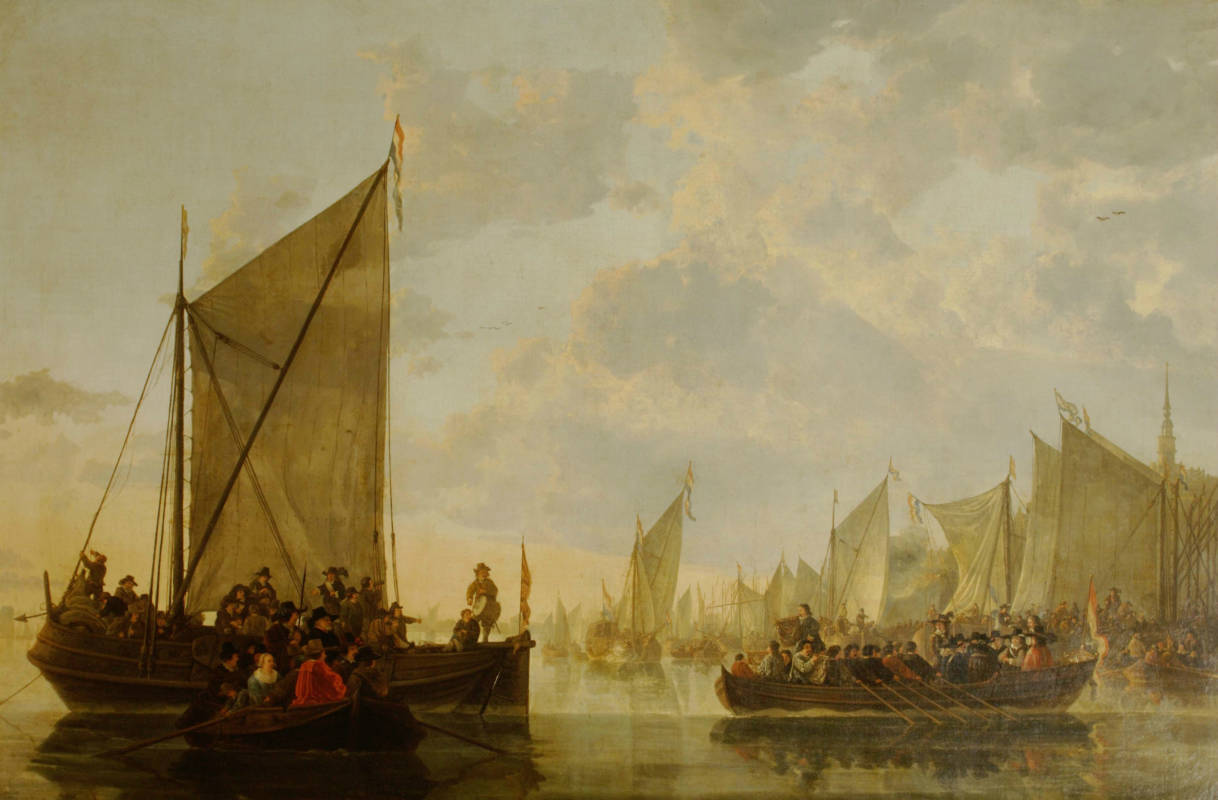
Aelbert Cuyp’s native Dordrecht serves as a backdrop to this historic gathering. A rowing boat, crowded with city dignitaries, heads into the morning mist, welcoming the return of the fleet. The flat sea and still pennants underline the sense of calm. Bugles signal their arrival and canon fire a salute from the city walls behind. This event marks the closing stages of the Eighty Years’ War – the conflict that culminated in the establishment of the Dutch Republic. The figure in the rowing boat, staring out at the viewer, may have commissioned Cuyp to record the occasion.
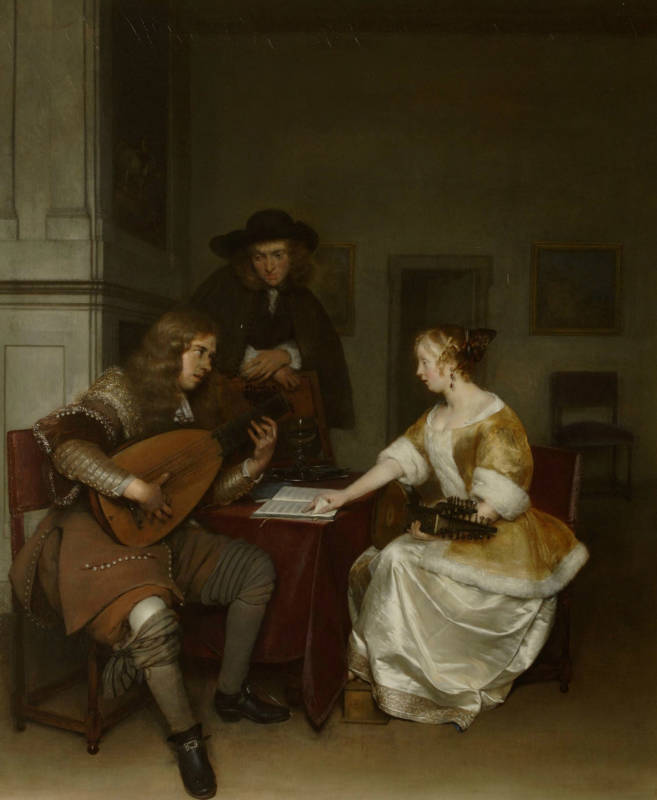
‘If music be the food of love…’
Gerard Ter Borch produced many paintings of ambiguous love encounters. The man playing the lute may be a client, a musical-partner, or perhaps a suitor… In Dutch genre painting, music making was often laden with associations of love. The man’s foot points firmly towards the woman’s foot warmer – suggestive of sexual desire. The woman’s white dress is depicted with the meticulous care – Ter Borch was famous for his virtuosic depiction of satin.
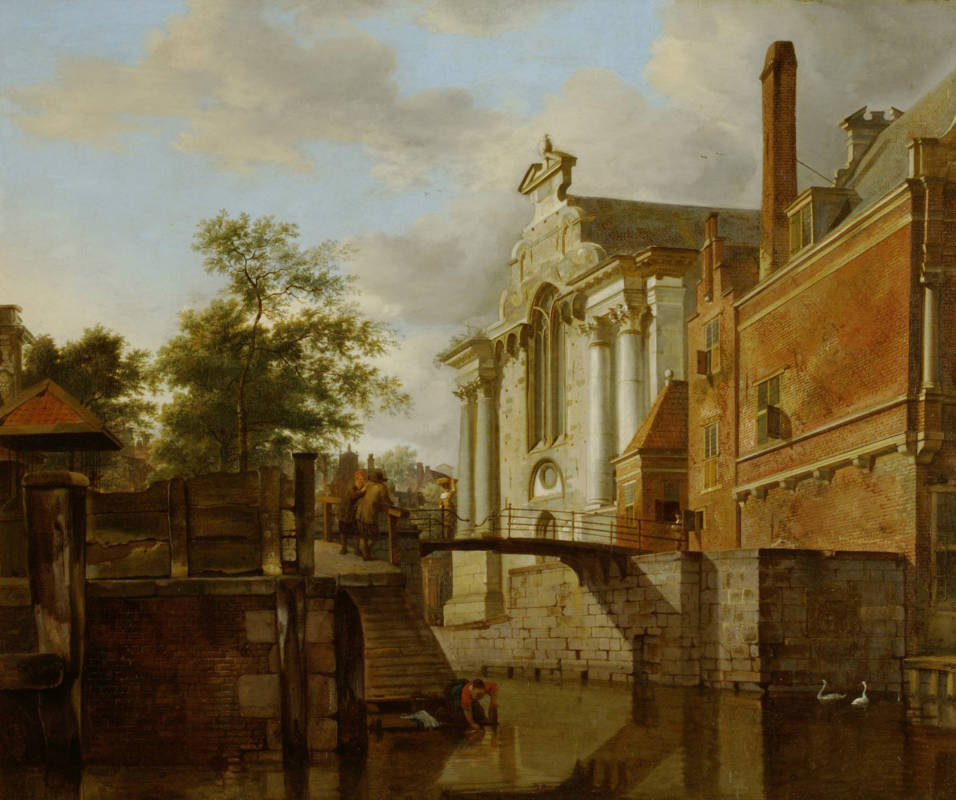
The buildings in this scene, depicting a tranquil backwater, are probably imaginary. The church combines Gothic and Baroque elements and the artist may have intended a subtle comment on the Protestant-inspired idolatory of the previous century. The scars on the façade are perhaps where religious sculptures were torn down. Jan van der Heyden specialised in townscapes. Less accomplished a figure painter, he often collaborated with other artists, including Adriaen van de Velde, who may have painted the washerwomen and passers-by.
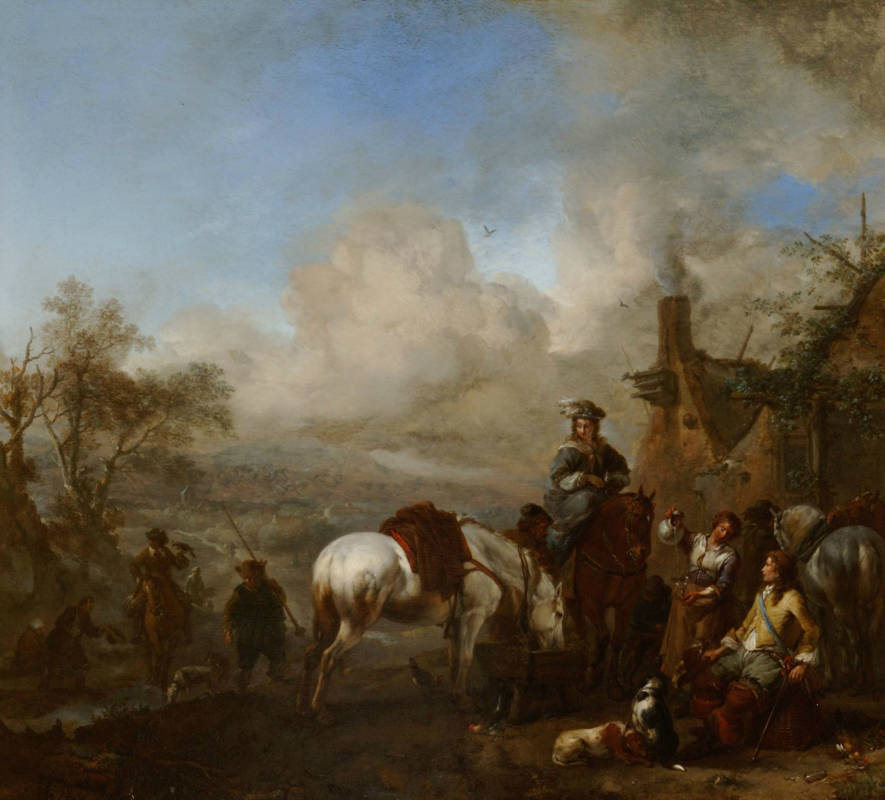
Philips Wouwermans excelled in the depiction of horses. The subject of travellers resting by an inn was one to which the artist returned on many occasions. The theme allowed Wouwermans to explore interactions between different members of society. The maid, emerging from the inn, pours a drink for the well-dressed couple who have just arrived. From her high vantage point the women observes a beggar, holding out his hat, pressing the huntsmen for alms. This is one of a few paintings that Ferdinand de Rothschild inherited from his father, Anselm.
Read more about Isack Van Ostade’s masterpiece>
Prized Possessions: Dutch Paintings from National Trust Houses >
Find out more about the Cultural Gifts Scheme >
by Michael Shrive, Curatorial Assistant






